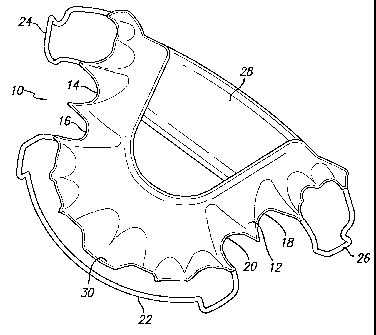Some of the information on this Web page has been provided by external sources. The Government of Canada is not responsible for the accuracy, reliability or currency of the information supplied by external sources. Users wishing to rely upon this information should consult directly with the source of the information. Content provided by external sources is not subject to official languages, privacy and accessibility requirements.
Any discrepancies in the text and image of the Claims and Abstract are due to differing posting times. Text of the Claims and Abstract are posted:
| (12) Patent Application: | (11) CA 2506609 |
|---|---|
| (54) English Title: | SLEEP APPLIANCE |
| (54) French Title: | ARTICLE D'AIDE AU SOMMEIL |
| Status: | Deemed Abandoned and Beyond the Period of Reinstatement - Pending Response to Notice of Disregarded Communication |
| (51) International Patent Classification (IPC): |
|
|---|---|
| (72) Inventors : |
|
| (73) Owners : |
|
| (71) Applicants : |
|
| (74) Agent: | G. RONALD BELL & ASSOCIATES |
| (74) Associate agent: | |
| (45) Issued: | |
| (86) PCT Filing Date: | 2004-06-01 |
| (87) Open to Public Inspection: | 2005-01-06 |
| Availability of licence: | N/A |
| Dedicated to the Public: | N/A |
| (25) Language of filing: | English |
| Patent Cooperation Treaty (PCT): | Yes |
|---|---|
| (86) PCT Filing Number: | PCT/US2004/017150 |
| (87) International Publication Number: | WO 2005000142 |
| (85) National Entry: | 2005-05-18 |
| (30) Application Priority Data: | ||||||
|---|---|---|---|---|---|---|
|
A dental oral appliance for use with patients who suffer with sleep disorders,
to reduce or eliminate snoring and to open the airway for a sleeping
individual who suffers with obstructive sleep apnea. The appliance covers the
inside (lingual) of the upper teeth and has an open palate. Retention for the
appliance is provided by clasps placed over the upper right and left molars
and a retainer in the anterior area from cuspid to cuspid. Over the upper
central incisors is a raised strip that extends from the incisal tip (biting
edge) of the central incisors toward the lingual. It extends back from the
middle of the central incisors, where they meet or touch each other, to the
middle of the palate. This raised anterior area is to separate the posterior
teeth to reduce spasm on the temporalis muscle. There is a transverse strip
that extends from the inside (lingual) of the upper right molars to the inside
of the upper left molars which covers the tongue, holding it down, opening the
airway.
L'invention concerne un appareil dentaire à utiliser chez des patients souffrant de troubles du sommeil, pour réduire ou éliminer le ronflement et pour ouvrir pendant son sommeil les voies ariennes d'une personne souffrant d'apnée obstructive. Cet appareil couvre l'intérieur (lingual) des dents supérieures et possède une voûte ouverte. La retenue de l'appareil est assurée par des agrafes placées sur les molaires gauches et droites supérieures et un élément de retenue dans la zone antérieure de canine à canine. Sur les incisives centrales supérieures une bande saillante est montée, s'étendant depuis la pointe incisive (le bord d'attaque) des incisives centrales jusqu'à la zone linguale. Elle s'étend vers l'arrière depuis le centre des incisives centrales, où elles se rencontrent ou se touchent, jusqu'au milieu du palais. Cette zone antérieure saillante est séparée des dents postérieures en vue de la réduction du spasme du muscle temporal. Une bande transversale s'étend depuis l'intérieur (lingual) des molaires droites supérieures jusque vers l'intérieur des molaires gauches supérieures et recouvre la langue, la maintenant en position basse et ouvrant les voies aériennes.
Note: Claims are shown in the official language in which they were submitted.
Note: Descriptions are shown in the official language in which they were submitted.

2024-08-01:As part of the Next Generation Patents (NGP) transition, the Canadian Patents Database (CPD) now contains a more detailed Event History, which replicates the Event Log of our new back-office solution.
Please note that "Inactive:" events refers to events no longer in use in our new back-office solution.
For a clearer understanding of the status of the application/patent presented on this page, the site Disclaimer , as well as the definitions for Patent , Event History , Maintenance Fee and Payment History should be consulted.
| Description | Date |
|---|---|
| Application Not Reinstated by Deadline | 2009-06-01 |
| Time Limit for Reversal Expired | 2009-06-01 |
| Deemed Abandoned - Failure to Respond to Maintenance Fee Notice | 2008-06-02 |
| Inactive: Cover page published | 2005-08-17 |
| Inactive: Notice - National entry - No RFE | 2005-08-17 |
| Inactive: Inventor deleted | 2005-08-15 |
| Inactive: Notice - National entry - No RFE | 2005-08-15 |
| Application Received - PCT | 2005-06-13 |
| National Entry Requirements Determined Compliant | 2005-05-18 |
| Application Published (Open to Public Inspection) | 2005-01-06 |
| Abandonment Date | Reason | Reinstatement Date |
|---|---|---|
| 2008-06-02 |
The last payment was received on 2007-05-22
Note : If the full payment has not been received on or before the date indicated, a further fee may be required which may be one of the following
Please refer to the CIPO Patent Fees web page to see all current fee amounts.
| Fee Type | Anniversary Year | Due Date | Paid Date |
|---|---|---|---|
| Basic national fee - small | 2005-05-18 | ||
| 2006-05-18 | |||
| MF (application, 2nd anniv.) - small | 02 | 2006-06-01 | 2006-05-18 |
| MF (application, 3rd anniv.) - standard | 03 | 2007-06-01 | 2007-05-22 |
Note: Records showing the ownership history in alphabetical order.
| Current Owners on Record |
|---|
| BRYAN KEROPIAN |
| Past Owners on Record |
|---|
| None |